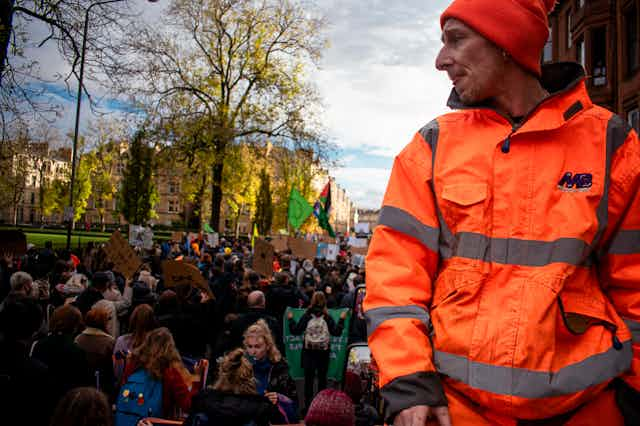Rachel Carson, a scientist and writer from rural Pennsylvania, published Silent Spring 60 years ago. Many credit this book, which meticulously documented the damage that DDT pesticides were inflicting on wildlife, farm animals and people as early as the 1950s, with launching the modern environmental movement.
Carson gathered stories from across the US to illuminate the dangers of indiscriminate pesticide use and the threats contaminated land posed to life. She would battle the chemical industry’s accusations of alarmism for the rest of her life. But Silent Spring struck a chord with a public increasingly sceptical of the ethics and efficacy of industrial society.
Carson’s criticism of the cosy relations between businesses and governments echoed the concept of the power elite, popularised by the New Left intellectual C. Wright Mills a few years earlier. In Mills’ assessment, American society was dominated by bureaucracies that included both big business but also organised labour.
Environmentalists who were inspired by Carson railed against these vested interests. They were dropouts and opponents of the established system, or at least outsiders to it. By 1990, Richard White, an American environmental historian, would pose the question “are you an environmentalist or do you work for a living?” White’s essay took aim at the environmental pretensions of white-collar professionals who pitted themselves against manual workers employed in polluting industries.
More recent scholarship has built on White’s insights, revealing the knowledge and respect for nature among such workers. Researchers have emphasised that it is these communities which have typically suffered most from pollution and industrial accidents. In The Myth of Silent Spring, social historian Chad Montrie told a story of the far more diverse coalitions which shaped American environmentalism.

Working-class environmentalism
Montrie underlined the role of automotive, oil, chemical and mining trade unions in campaigning for environmental improvements from the beginning of the 1960s, when Carson’s book was making waves. The United Auto Workers supported campaigns for fresh air and clean water in American cities such as Detroit, Michigan while the United Farm Workers shared Carson’s opposition to the pesticides poisoning their members in the fields of California.
Montrie also highlighted the role of civil rights activists in shaping demands for environmental justice among poor and working-class black Americans. This inspired campaigns against lead poisoning in cities such as St Louis, Missouri and for cleaner air quality in Gary, Indiana. These groups worked with those who more closely resembled the received image of Carson-inspired environmentalists.
My ongoing research about community and workplace experiences of energy transitions in the UK has exposed something similar. I have recorded testimonies from middle-class environmentalists who joined protests such as Friends of the Earth’s 1971 campaign against Schweppes’ policy of non-returnable bottles. Many of these people found their fellow campaigners on university campuses, in left-wing bookshops and wholefoods stores. These places became important recruiting grounds for the anti-nuclear movement too. Activists from this milieu organised demonstrations against the building of the Torness nuclear power station in East Lothian, Scotland, during the late 1970s and early 1980s.
These were rarely concerns held by university graduates alone. The Torness campaign enjoyed support from farmers who aided activists occupying the power station site. They also provided the spectacle of a cavalcade of tractors driving through the centre of Edinburgh in support of the protest.
One example of working-class agitation for environmental action can be found in the records of the Scottish Trades Union Congress. At the union confederation’s 1972 annual meeting, W.B. Blairford of the electricians’ union moved an anti-pollution resolution which set an agenda for class-conscious environmentalism. He said that while environmentalism was seen as a “largely academic and middle-class trend”, it was “vital that the interests of the workers were fully represented in this important debate”.
He highlighted smelter workers suffering industrial illnesses, asbestos exposure among factory workers and the dangerous conditions coal miners endured, as well as contemporary studies on pollution near steelworks in Durham and cement factories in Hampshire to argue that “it was the workers who suffered most from pollution at home”.

These sentiments were not confined to conference resolutions either. In one instance of industrial action that would affect the UK’s policy for nuclear waste storage, the National Union of Seamen refused to cooperate with dumping radioactive material at sea during the early 1980s.
Extractors against extractivism
These are formative trends in the modern environmentalism of anglophone societies and deindustrialisng economies. This makes sense in understanding a movement shaped by the popularity of Silent Spring. But it overlooks many of the communities bearing the brunt of environmental crises like climate change.
A more combative activism emerged in the activities of trade unionists and indigenous groups in Latin America. Ecuador saw movements opposed to the oil industry develop broader criticisms of extractivismo: a rejection of any economic model predicated on extracting resources wrongfully acquired through colonialism.
This rejects the older socialist case for economic development through national ownership of oil and minerals, and finds common cause with campaigners in more recently formed groups like Extinction Rebellion. The fruitfulness of any potential collaboration is unknown. Extinction Rebellion has rejected political alignments before.
These debates and others like them will determine the future of environmentalism. Already, there are glimmers of what is possible. Visitors to Glasgow during the most recent UN climate change summit may have seen Greta Thunberg marching with striking refuse workers and campaigners from islands threatened with sea-level rise and landscapes scarred by oil and mineral extraction.

